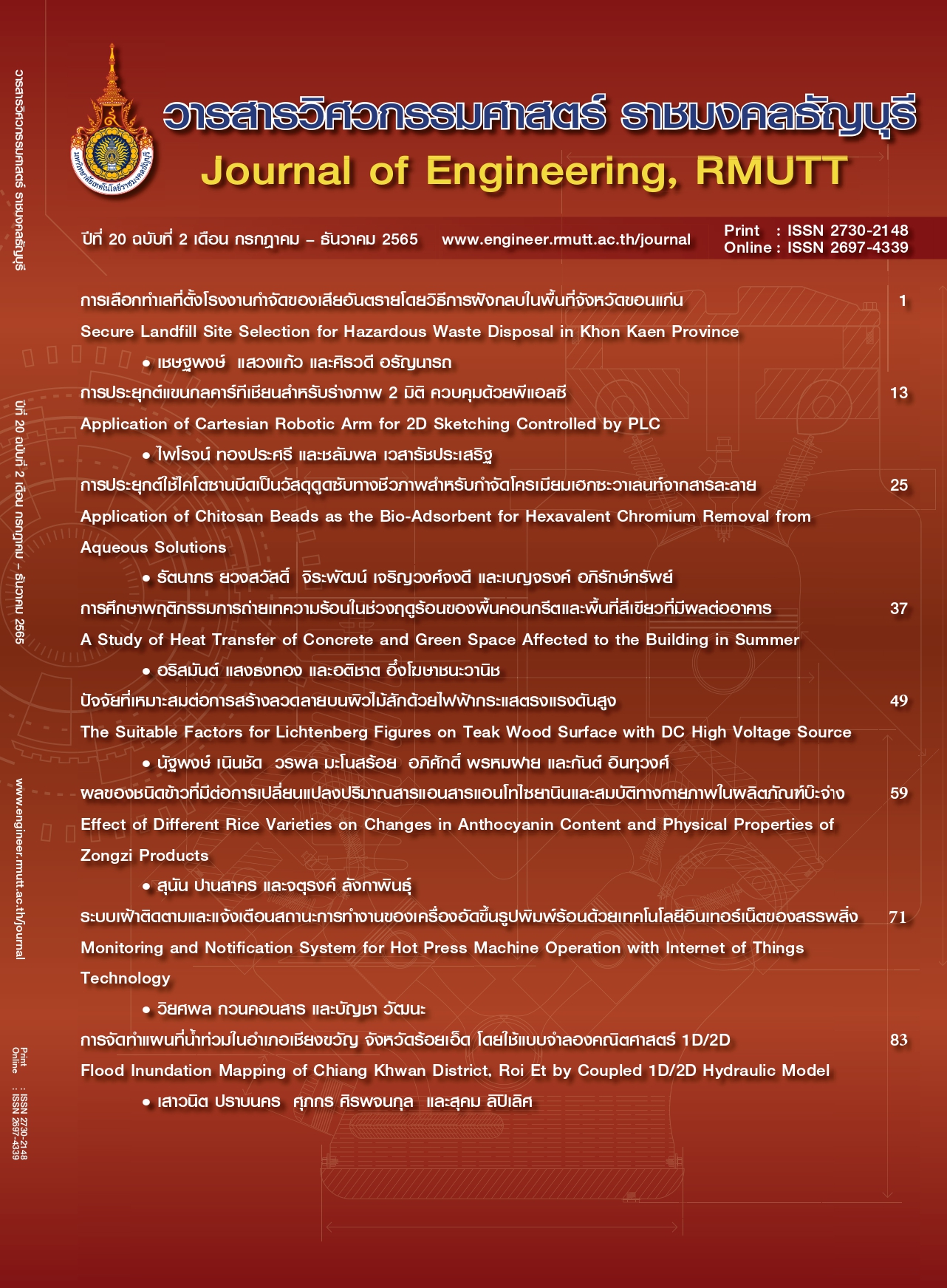การศึกษาพฤติกรรมการถ่ายเทความร้อนในช่วงฤดูร้อนของพื้นคอนกรีต และพื้นที่สีเขียวที่มีผลต่ออาคาร
Main Article Content
บทคัดย่อ
บทความวิจัยนี้มีวัตถุประสงค์เพื่อศึกษาพฤติกรรมการถ่ายเทความร้อนในช่วงฤดูร้อนของพื้นคอนกรีต
และพื้นที่สีเขียวที่มีผลต่ออาคาร โดยเก็บข้อมูลอุณหภูมิในแต่ละชั้นความหนาของพื้นผิวทั้ง 2 แบบ ที่ระดับความลึก
-15.00 ซม., -7.50 ซม.และ 0.00 ซม.ตามลำดับ และอุณหภูมิแวดล้อม ซึ่งเก็บข้อมูลอุณหภูมิเมื่อครบ 1 นาที เป็นเวลา
24 ชั่วโมง ต่อเนื่องกันเป็นเวลา 7 วัน ภายใต้เงื่อนไขสภาพพื้นที่แบบชานเมือง ไม่มีอาคารสูง อาคารมีขนาดไล่เลี่ยกัน
พื้นผิวรอบอาคาร ร้อยละ 30 จากพื้นที่ทั้งหมดร้อยละ 100 โดยสภาพอากาศเป็นวันที่มีแดดออกจัด เพื่อต้องการนำข้อมูลอุณหภูมิที่เกิดขึ้นในระดับความลึกที่แตกต่างกันของพื้นผิวเดียวกันและที่พื้นผิวแตกต่างกันในระดับความลึกเดียวกัน ของช่วงเวลากลางวันและกลางคืน มาอธิบายการถ่ายเทความร้อนตามเงื่อนไขที่กำหนด โดยใช้สมการการแพร่วิเคราะห์อุณหภูมิที่เกิดขึ้นกับอาคาร จากการศึกษา พบว่า การถ่ายเทความร้อนในแนวดิ่งของพื้นที่ต่างชนิดกันส่งผลให้อุณหภูมิถ่ายเทไม่สมบูรณ์เนื่องจากมีการสกัดกั้นการถ่ายเทความร้อนเข้าสู่พื้นชั้นถัดไปด้วยเหตุนี้จึงส่งผลให้การถ่ายเทความร้อนในแนวราบที่เป็นพื้น ชนิดเดียวกันทำได้ดีกว่าการส่งต่อเข้าสู่พื้นอาคาร ฉะนั้นพื้นอาคารที่ถูกรายล้อมด้วยพื้นที่สีเขียวจึงมีความร้อนสะสมน้อยกว่า พื้นอาคารที่ถูกรายล้อมด้วยพื้นคอนกรีตเป็นเหตุให้ในช่วงฤดูร้อนพื้นคอนกรีตบริเวณโดยรอบอาคารสะสมความร้อนให้กับพื้นอาคารสูงกว่าพื้นที่สีเขียว ทั้งในช่วงเวลากลางวันและเวลากลางคืน
Article Details

อนุญาตภายใต้เงื่อนไข Creative Commons Attribution-NonCommercial-NoDerivatives 4.0 International License.
บทความ ข้อมูล เนื้อหา รูปภาพ ฯลฯ ที่ได้รับการตีพิมพ์ในวารสารแนวหน้าวิจัยนวัตกรรมทางวิศวกรรม ถือเป็นลิขสิทธิ์ของวารสารฯ เท่านั้น ไม่อนุญาติให้บุคคลหรือหน่วยงานใดคัดลอกเนื้อหาทั้งหมดหรือส่วนหนึ่งส่วนใดไปเผยแพร่เพื่อกระทำการใด ๆ ที่ไม่ถูกต้องตามหลักจริยธรรม
เอกสารอ้างอิง
Khamchiangta D, Dhakal S. Physical and non-physical factors driving urban heat island: case of Bangkok metropolitan administration. Thailand. Journal of Environmental Management. 2019, 248:1-13. (in Thai)
Puljan V, Luangwilai T, Welamas W, Meechowna S, Leelayuth S, Moodleah S. Investigating the behavior of heat transfer through building walls with different covering materials by using Method of Lines (MOL). NKRAFA Journal of Science and Technology. 2021;17(1):1-10. (in Thai)
Nuntasiri P, Rasisuttha S. Thermal comfort of low income people: case study of Baan Mankong Non Nong Wat 2. Academic Journal: Faculty of Architecture, Khon Kaen University. 2558;14(2):127-41. (in Thai)
Intaraksa A. Role of latent heat flux and sensible heat flux in urban zoning, design and planning [dissertation]. [Bangkok (TH)]: Kasetsart University; 2014.
Lamananchai T. Weather warning. Thai Meteorological Department; 2022.
Weather report on 2021. Available from: https:// www.tmd.go.th/province_weather_stat.php?StationNumber=48455
Teanmanee T. Urban heat island and urban physical environment [master’s thesis]. [Bangkok (TH)]: Silpakorn University; 2022.
Rasitanon T. The thermal comfort and adaptability to living for Muslim on the coast area Songkhla province [master’s thesis]. [Songkla (TH)]: Prince of Songkla University; 2010.
Takkanon P. Thermal comfort: basic and models for hot and humid climates. Journal of the Faculty of Architecture Silpakorn University. 2005;21:133-46. (in Thai)
rivanit M, Auttarat S. The summer thermal environment and human comfort of shaded outdoor and semi-outdoor spaces to living in the urban area of Chiang Mai city. Journal of Architectural/Planning research and studies (JARS). 2015;12(2):53-72. (in Thai)
Norkaew S, Sangkaew Y, Yarak P, Wisetmuenwai O, Ketsakorn A. Assessment of indoor air quality in the lecture room of undergraduate students in a university in Pathumthani province. Journal of Safety and Health. 2022;15(1):173-86. (in Thai)
Khetkrathok N, Suluksna K. Guidelines for the management of thermal comfort conditions in air-conditioned areas for energy saving case study library building Suranaree university of technology. Ladkrabang Engineering Journal. 2019;36(1):17-24. (in Thai)
Wattanavichin P. The experimental study of thermal behavior with Phase Change Material Thermal Shield (PCMTS) inside lightweight wall during the daytime [thesis]. [Bangkok (TH)]: Thammasat University; 2015.
Wongkhunkaew P, Konyai S. Effect of climate variability on sugarcane production of northeastern Thailand. 22nd National Graduate Research Conference. 2021:7-14. (in Thai)
Ruengsillapanun K, Udtaranakron T, Pulngern T, Tangchirapat W, Jaturapitakkul C. Mechanical properties, shrinkage, and heat evolution of alkali activated fly ash concrete. Construction and Building Materials. 2021;299:1-14.
Liqun H, Yangyang L, Xiaolong Z, Shaowen D, Zhuangzhuang, Hao L.H. Temperature characteristics of porous portland cement concrete during the hot summer session. Hindawi Advances in Materials Science and Engineering. 2017:1-10.


